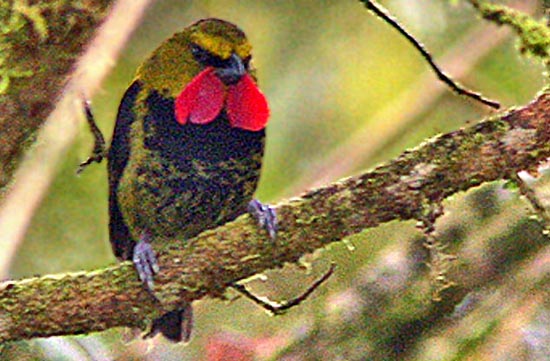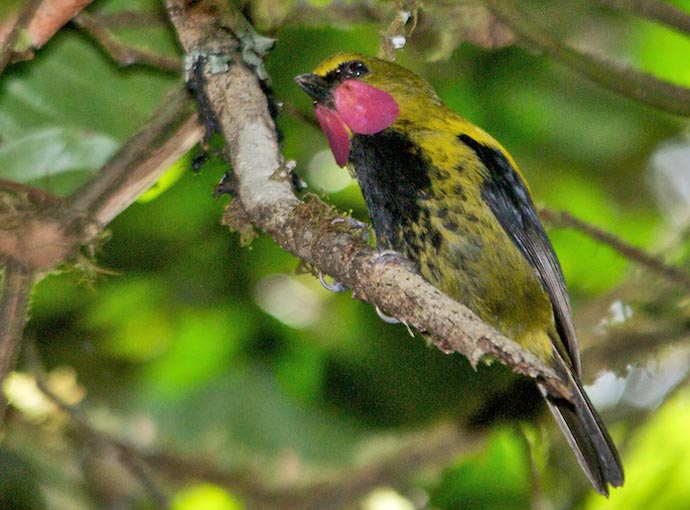
a web page by Don Roberson |
PLOUGHBILL Eulacestomatidae |
|
|
Handbook of Birds of the World (Sherman 1996) included it with Whistlers and Norman et al. (2009) placed the Ploughbill close to whistlers. For a time, IOC places it in "Family Incertae Sedis" [=family uncertain] between Sittellas and Whistlers [listing Crested Shrike-tit as the nearest species in Whistlers]. Jønsson et al. (2011) sequenced DNA for a wide variety of corvoid birds. They found that both Wattled Ploughbill and Sitellas [Daphoenositta] to be early offshoots in the corvoid tree among the lineages that led to whipbirds, tit-berrypeckers and painted berrypeckers, and, perhaps, jewel-babblers. The Ploughbill thus appears to be of ancient lineage. Schodde & Christidis (2014) proposed full Family status for this unique species. The proposal was supported by further molecular evidence, using 8 nuclear and 4 mitochondrial loci, in Jønsson et al. (2016), who placed this family between Shrike-tits [Falcunculidae] and Painted Berrypeckers [Paramythiidae]. With these new publications, it seems likely that most world checklists will adopt the Eulacestomatidae as a single-species family. |
 Coates
(1990) describes Wattled Ploughbill (right, a nice shot by Simon
Woolley & Julia Casson) as preferring thickets of climbing bamboo
in the mountains of New Guinea, mostly between 1950–2850m [= 6400–9400
ft.]. It is fairly common in southeastern New Guinea but elsewhere
rather rare. Behavior is active and acrobatic, gleaning from branches
and limbs, and leaning over to inspect the undersides of branches.
Vocalizations include a long whistled-note (like a jewel-babbler), or a
this series of such notes, or a buzzy note (Beehler et al. 1986). Coates
(1990) describes Wattled Ploughbill (right, a nice shot by Simon
Woolley & Julia Casson) as preferring thickets of climbing bamboo
in the mountains of New Guinea, mostly between 1950–2850m [= 6400–9400
ft.]. It is fairly common in southeastern New Guinea but elsewhere
rather rare. Behavior is active and acrobatic, gleaning from branches
and limbs, and leaning over to inspect the undersides of branches.
Vocalizations include a long whistled-note (like a jewel-babbler), or a
this series of such notes, or a buzzy note (Beehler et al. 1986). |
Photos: David Bishop photographed the Wattled Ploughbill Eulacestoma nigropectus at Ambua Lodge, Papua New Guinea, in Oct 2011. Simon Woolley & Julia Casson photographed their Ploughbill at Tari, Papua New Guinea, in July 2009. Credited photos © David Bishop and © Simon Woolley & Julia Casson, as credited, and used with permission; all rights reserved. Bibliographic note: There is no "family book" on this new family, but an introduction to this species is in Boles (2007). Literature cited:
|
 Wattled Ploughbill
is an enigmatic passerine of cloud forests in central New Guinea (left,
an impressive shot by David Bishop). It has traditionally been aligned
with pitohuis and/or shrike-thrushes — which at times have been placed
with Whistlers (Pachycephalidae) or split out as a different family.
Sibley & Monroe (1990) placed it in tribe Pachycephalini within a
huge family Corvidae. Howard & Moore world checklist (Dickinson
2003) put it with Crested Shrike-tit Falcunculus frontatus in
a new family Falcunculidae; in fact, an old name for this species was
"Wattled Shrike-Tit." I had placed it there for a time. This suggestion
was not supported by the molecular studies of Norman et al. (2009) or
of Jønsson et al. (2011).
Wattled Ploughbill
is an enigmatic passerine of cloud forests in central New Guinea (left,
an impressive shot by David Bishop). It has traditionally been aligned
with pitohuis and/or shrike-thrushes — which at times have been placed
with Whistlers (Pachycephalidae) or split out as a different family.
Sibley & Monroe (1990) placed it in tribe Pachycephalini within a
huge family Corvidae. Howard & Moore world checklist (Dickinson
2003) put it with Crested Shrike-tit Falcunculus frontatus in
a new family Falcunculidae; in fact, an old name for this species was
"Wattled Shrike-Tit." I had placed it there for a time. This suggestion
was not supported by the molecular studies of Norman et al. (2009) or
of Jønsson et al. (2011).